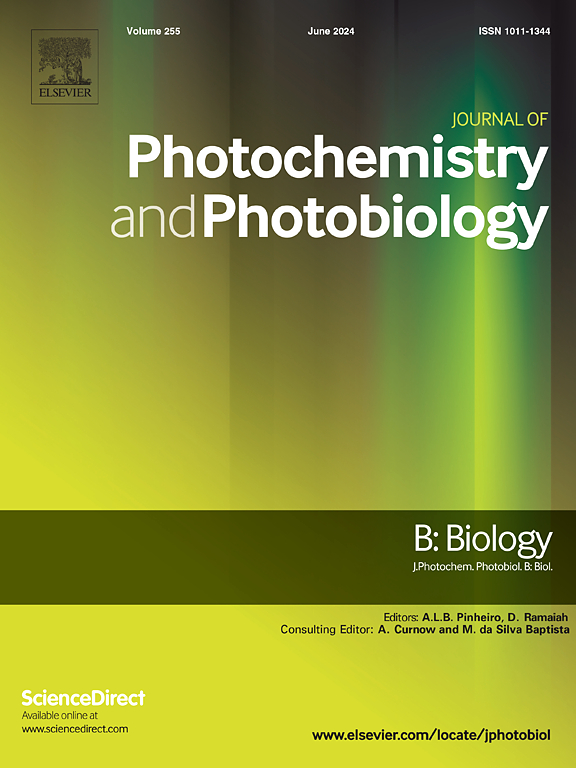Infrared-A (IR-A) modulates the p53 pathway and diurnal clock in human skin and subcutaneous adipose tissue in vivo
IF 3.9
2区 生物学
Q2 BIOCHEMISTRY & MOLECULAR BIOLOGY
Journal of photochemistry and photobiology. B, Biology
Pub Date : 2025-06-04
DOI:10.1016/j.jphotobiol.2025.113199
引用次数: 0
Abstract
Infrared-A (IR-A) radiation is thought to protect the skin from damage due to ultraviolet radiation and alter its carcinogenic potential, possibly by preventing keratinocyte apoptosis via p53 pathway modulation. Solar radiation, including IR-A, is a major factor in contributing to the entrainment of circadian rhythms. We examined the impacts of IR-A on the intrinsic clock and transcriptomics in individuals with different diurnal preference to understand the mechanisms by which IR-A acts in the human skin and subcutaneous adipose tissue. IR-A caused multiple gene expressional changes, mainly as immediate stress responses in 15 min, that were reversed within 24 h. IR-A irradiation increased the skin surface temperature (mean peak temperature 42.9 °C). In skin, the zinc finger proteins ZNF490 and ZNHIT2 correlated negatively with the maximum skin surface temperature. In adipose tissue, CDKN1A, which codes p21 protein, had a negative correlation with the skin surface temperature change. In the skin immunohistochemical staining, the circadian regulators CRY1 and CRY2 increased significantly 24 h after the irradiation, CRY1 already in 15 min. According to the diurnal preferences, morning-type individuals develop mostly innate immune responses, whereas evening-type of individuals had more pronounced responses through p53 pathway modulation, apoptosis, and autophagy.
红外- a (IR-A)在体内调节人体皮肤和皮下脂肪组织中的p53通路和昼夜时钟
红外- a (IR-A)辐射被认为可以保护皮肤免受紫外线辐射的伤害,并改变其致癌潜力,可能是通过p53通路调节防止角质细胞凋亡。太阳辐射,包括IR-A,是导致昼夜节律紊乱的一个主要因素。我们研究了IR-A对具有不同昼夜偏好的个体内在时钟和转录组学的影响,以了解IR-A在人体皮肤和皮下脂肪组织中的作用机制。IR-A引起多个基因表达变化,主要表现为15分钟内的即时应激反应,在24小时内发生逆转。IR-A照射使皮肤表面温度升高(平均峰值温度42.9℃)。在皮肤中,锌指蛋白ZNF490和ZNHIT2与皮肤最高表面温度呈负相关。在脂肪组织中,编码p21蛋白的CDKN1A与皮肤表面温度变化呈负相关。在皮肤免疫组化染色中,昼夜节律调节因子CRY1和CRY2在照射后24 h显著升高,CRY1在照射后15 min就已经升高。根据昼夜偏好,早起型个体主要产生先天免疫应答,而晚睡型个体通过p53通路调节、细胞凋亡和自噬产生更为明显的应答。
本文章由计算机程序翻译,如有差异,请以英文原文为准。
求助全文
约1分钟内获得全文
求助全文
来源期刊
CiteScore
12.10
自引率
1.90%
发文量
161
审稿时长
37 days
期刊介绍:
The Journal of Photochemistry and Photobiology B: Biology provides a forum for the publication of papers relating to the various aspects of photobiology, as well as a means for communication in this multidisciplinary field.
The scope includes:
- Bioluminescence
- Chronobiology
- DNA repair
- Environmental photobiology
- Nanotechnology in photobiology
- Photocarcinogenesis
- Photochemistry of biomolecules
- Photodynamic therapy
- Photomedicine
- Photomorphogenesis
- Photomovement
- Photoreception
- Photosensitization
- Photosynthesis
- Phototechnology
- Spectroscopy of biological systems
- UV and visible radiation effects and vision.

 求助内容:
求助内容: 应助结果提醒方式:
应助结果提醒方式:


